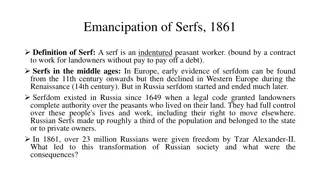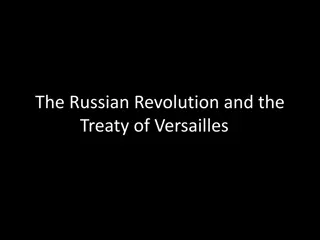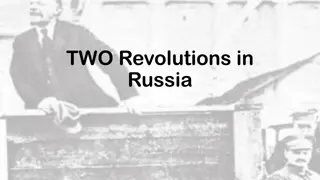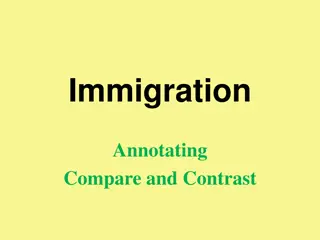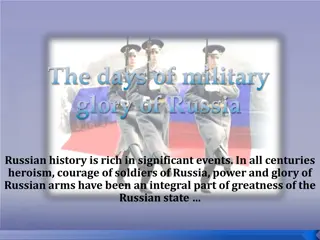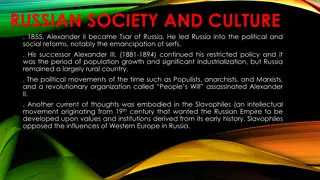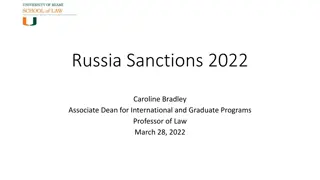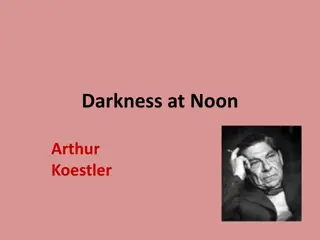The Russian Revolution: Turmoil and Transformation in Czarist Russia
Czar Nicholas II's ineffectual leadership, Russia's disastrous involvement in World War I, the rise of Rasputin's influence, and the February Revolution marked a period of unrest and transition in early 20th-century Russia, leading to the eventual downfall of the Romanov dynasty.
Download Presentation

Please find below an Image/Link to download the presentation.
The content on the website is provided AS IS for your information and personal use only. It may not be sold, licensed, or shared on other websites without obtaining consent from the author.If you encounter any issues during the download, it is possible that the publisher has removed the file from their server.
You are allowed to download the files provided on this website for personal or commercial use, subject to the condition that they are used lawfully. All files are the property of their respective owners.
The content on the website is provided AS IS for your information and personal use only. It may not be sold, licensed, or shared on other websites without obtaining consent from the author.
E N D
Presentation Transcript
Dr.Vishwajeet Singh Parmar Ancient Indian History Cultutre & Archaeology Vikram University, Ujjain (M.P.) BA IV SEMESTER THE RUSSIAN REVOLUTION Part-2
Nicholas II : After the bloodshed of 1905, Czar Nicholas II promised the formation of a series of representative assemblies, or Dumas, to work toward reform. Russia entered into World War I in August 1914 in support of the Serbs and their French and British allies. Their involvement in the war would soon prove disastrous for the Russian Empire.
Militarily, imperial Russia was no match for industrialized Germany and Russian casualties were greater than those sustained by any nation in any previous war. Food and Fuel shortages plagued Russia as inflation mounted. The economy was hopelessly disrupted by the costly war effort. Czar Nicholas left the Russian capital of Petrograd (St. Petersburg) in 1915 to take command of the Russian Army front. (The Russians had renamed the imperial city in 1914, because the name St. Petersburg had sounded too German.)
Rasputin and the Czarina : In her husband s absence, Czarina Alexandra- an unpopular woman of German ancestry- began firing elected officials. During this time , her controversial advisor, Grigori Rasputin, increased his influence over Russian politics and the Royal Romanov Family. Russian nobles eager to end Rasputin s influence murdered him on December 30, 1916. By then, most Russians had lost faith in the failed leadership of the Czar. Government corruption was rampant, the Russian economy remained backward and Nicholas repeatedly dissolved the Duma, the toothless Russian parliament established after the 1905 revolution, when it opposed his will.
February Revolution : The February Revolution (known as such because of Russia s use of the Julian Calendar until February 1918) began on March 8, 1917 (February 23 on the Julian Calendar). Demonstrators clamoring for bread took to the streets of Petrograd. Supported by huge crowds of striking industrial workers, the protesters clashed with police but refused to leave the streets.
On March 11, the troops of the Petrograd army garrison were called out to quell the uprising. In some encounters, the regiments opened fire, killing demonstrators, but the protesters kept to the streets and the troops began to waver.
The Duma formed a provisional government on March 12. A few days later, Czar Nicholas abdicated the throne, ending centuries of Russian Romanov rule. The leaders of the provisional government, including young Russian lawyer Alexander Kerensky, established a liberal program of rights such as freedom of speech, equality before the law and the right of unions to organize and strike. They opposed violent social revolution.
As minister of War, Kerensky continued the Russian War effort, even though Russian involvement in World War I was enormously unpopular. This further exacerbated Russia s food supply problems. Unrest continued to grow as peasants looted farms and food riots erupted in the cities. To be continued ..








